7 Collaboration Across Development and Delivery Phases
![]() To offer authentic, credible, useful, and relevant learning, many collaborators should be involved in the design and development of micro-credentials. With that in mind, it is first important to clarify the goals of collaboration: are you collaborating or are you consulting? Collaboration relies on:
To offer authentic, credible, useful, and relevant learning, many collaborators should be involved in the design and development of micro-credentials. With that in mind, it is first important to clarify the goals of collaboration: are you collaborating or are you consulting? Collaboration relies on:
It is important to clarify the goals of collaboration: are you collaborating or are you consulting? Collaboration relies on:
- Relationship-perspectives rather than a transactional approach
- Embracing the process versus pursuing a predetermined goal or outcome
- Time to build an ongoing relationship
- Trust
- Listening skills
To develop a micro-credential collaboratively, partnerships need to be fostered and stewarded. One approach to consider is “design thinking,” which focuses on users and their needs. It places people at the centre of the design process, and frames the problem, or the need, as central to the design (Morris & Warman, 2015). It might also be helpful to explore Tuck’s theory of group development, which outlines the different stages groups move through when working collaboratively: Forming, Storming, Norming, Performing, and Adjourning (Stein, n.d.).
A project charter is a very useful tool for shaping a conversation about developing a micro-credential. The template below provides a starting point; you can adapt it as needed as you build a micro-credential offering collaboratively.
Project charter: A tool for practitioners
A project charter ends up being really a useful way of shaping a conversation in a meeting. The project charter template included in this section provides a starting point for you to adapt as you build a micro-credential offering collaboratively:
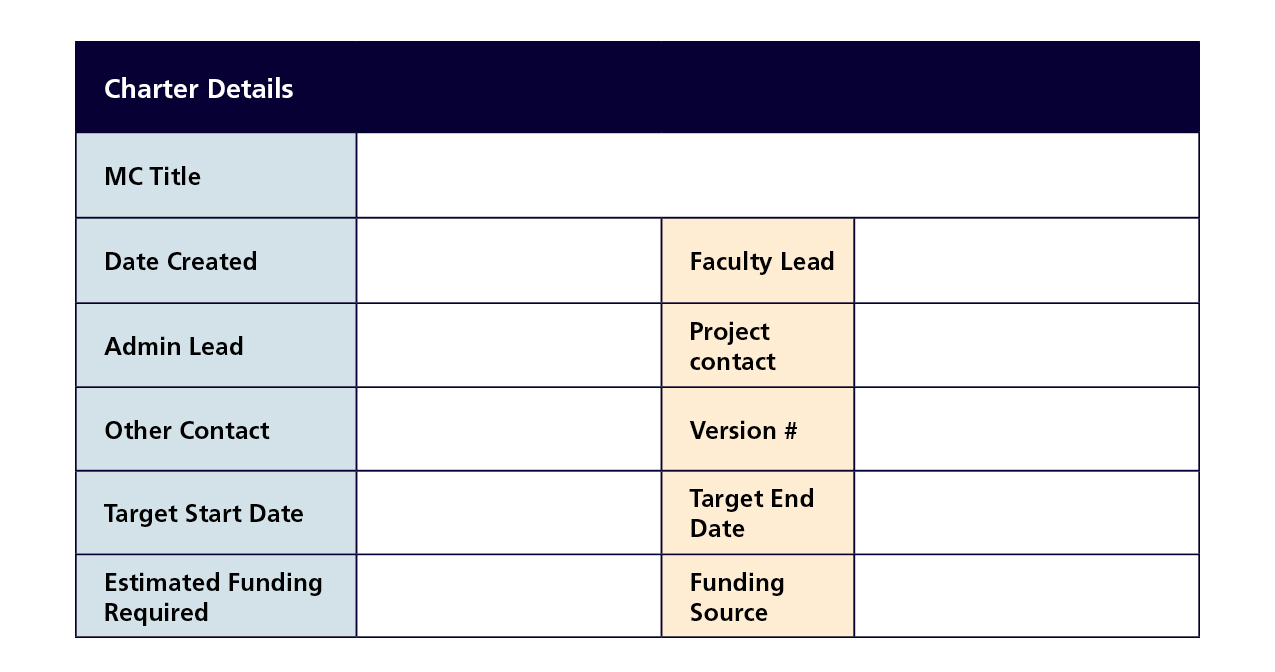

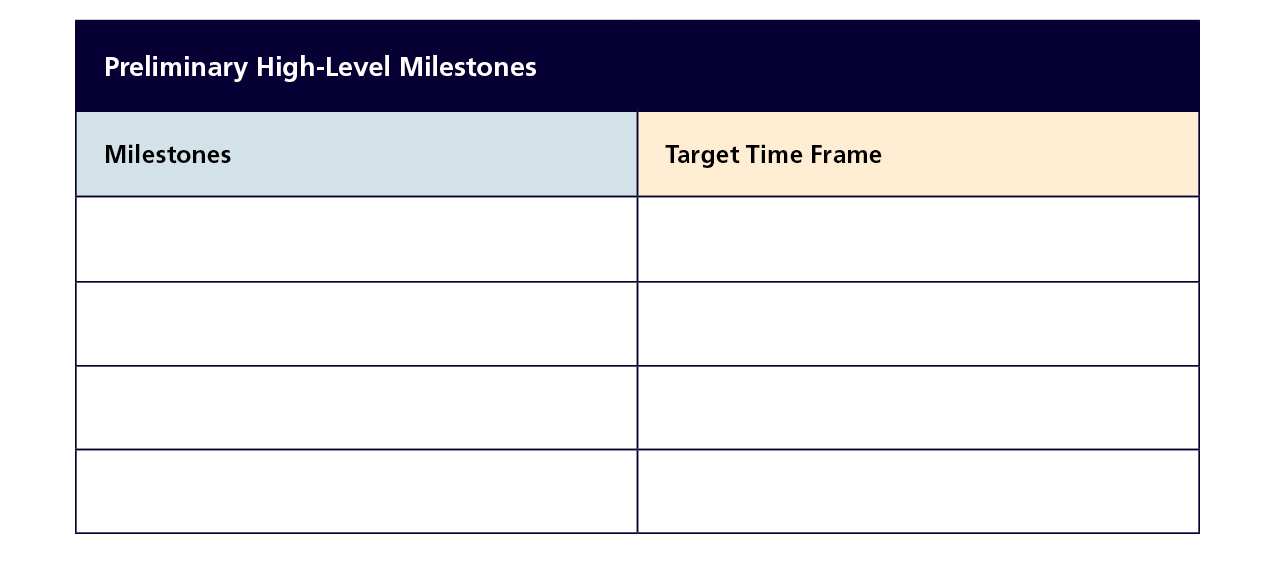
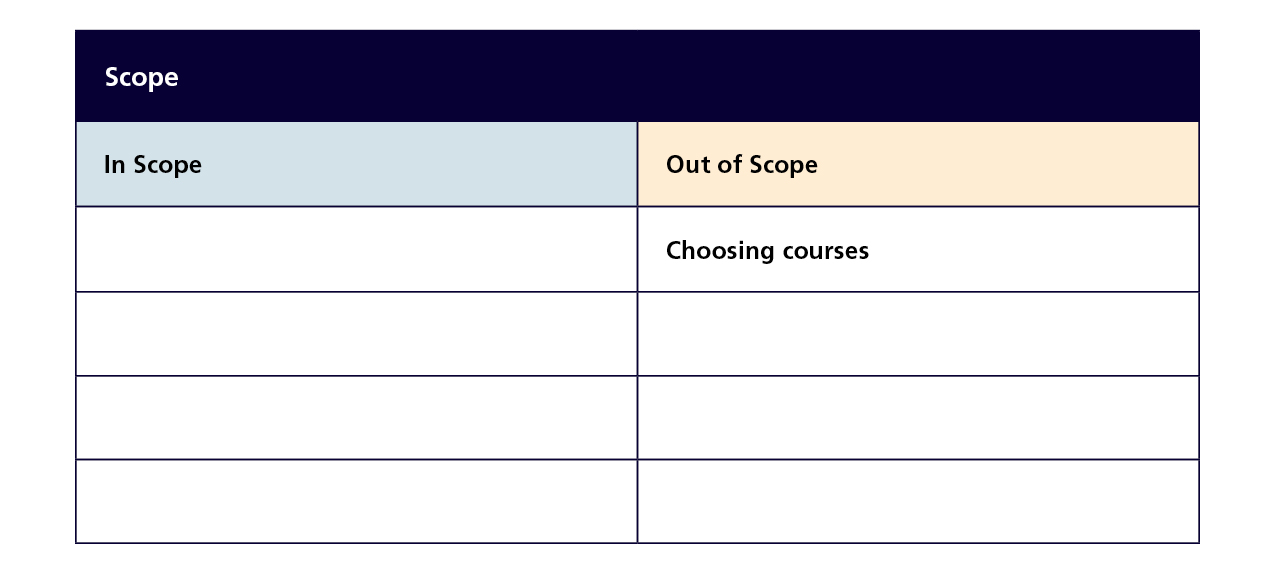
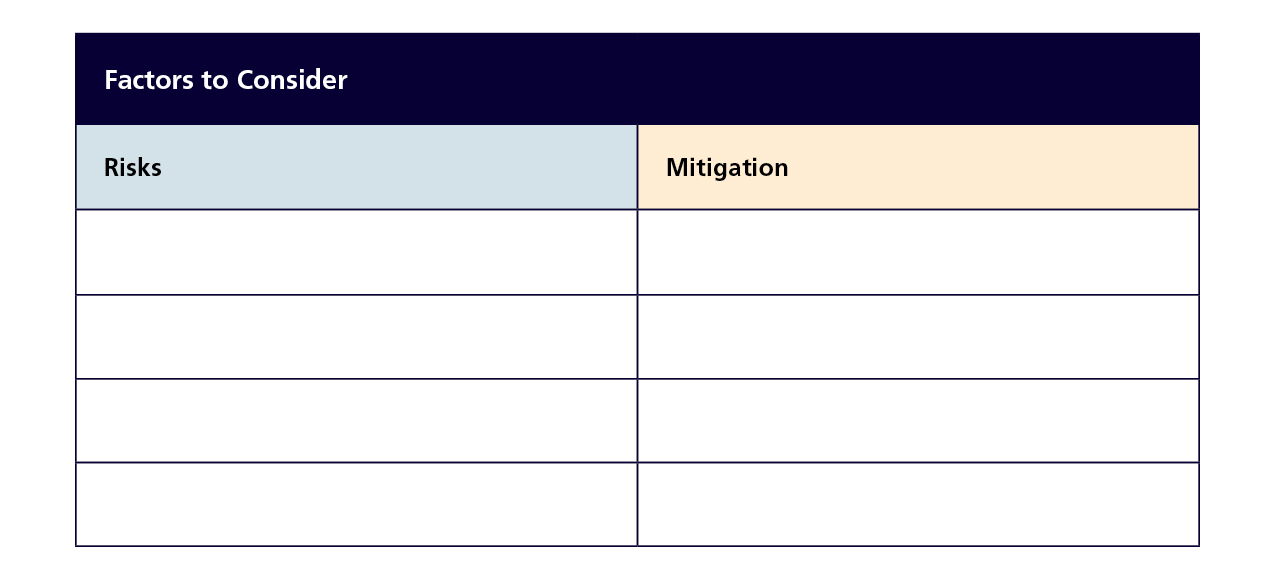

Collaborators are an essential to every stage of the micro-credential development, from design and development through to marketing. Collaborators will come from various departments within the institution and external stakeholders such employers, industries, and professional bodies. Each section below provides a list of possible collaborators for each phase of development.
Design and development collaborators
In the first phase of design and development, meeting with stakeholders is important to learn more about training needs and skills required in specific industries and professions. Each collaborator has a different journey to micro-credentials and collaboration pathways.
Collaborators include :
-
- Industry experts, employers, partners, and individuals from professional bodies
- Project manager
- Instructional designer or curriculum developer
- Quality assurance specialist or quality matters coordinator
- Subject matter experts (could be the industry experts mentioned above)
- E-learning development and design team
- Chairs, deans, or faculty members
Stories from practitioners: Collaborating with employers
When I conducted several focus group sessions with employers, partners, and industries last year, I learned that many graduates of college-level programs were still lacking specific skills and competencies to perform the job effectively. The feedback that I received form these stakeholders helped me and my design and project team to develop micro-credentials that were tailored and designed to meet these specific training needs and gaps. I worked with these industries to learn what would be needed concerning curriculum to ensure that learners completing these micro-credentials would indeed have the required skill set to complete the job effectively. Having these stakeholders involved in the process early on helped me to ensure that curriculum was designed to address these gaps, and that assessments were intentionally selected to measure the specific skill, competency, or knowledge gained.
Without this collaborative process, our design team would have been designing micro-credentials that most likely would not have met the upskilling and retraining needs that these industries were requiring; more importantly, these industries and professionals were elated to participate and were thankful that they could be a part of this journey of creating a specific micro-credential framework tailored to their particular industry. Additionally, with this collaboration, I was able to ensure that assessments were intentionally selected to measure the competency that was being assessed and mastered. With these collaborators, the learning goals of the micro-credential were easily identified, as well as the assessments that were chosen. Many of these industry partners ended up being subject matter experts who I hired to create the content for our micro- credentials, which was also an excellent benefit of collaboration. – Anonymous
Implementation and delivery collaborators
Collaborators bring different expectations with them to micro-credential development and delivery, as shown in the figure below. With the aim of micro-credentials being to build employability or market-ready skills, collaborators should have input on what, who, and how they are taught. For learners, micro-credentials might offer pathways to personal success and future opportunities. For educators, micro-credentials represent opportunities to apply skills and knowledge to a particular skill need or gap. For employers, micro-credentials can signal graduate and employee skills and training (Mhichílet al., 2021 ).
Collaborators include:
- Registrar’s office
- Marketing department
- IT department
- HR department
- Student success/counselling office
- Continuing education
- Deans and chairs
Stories from practitioners: Collaborating in your institution
When I initiated the micro-credential competency-based framework at the post-secondary institution that I was employed with, I learned that collaboration with several departments needs to happen early in the design phase; this included collaboration with the following departments: IT, the registrar’s office, marketing, HR, student success/counselling office, program coordinators, faculty, deans, teaching and learning departments and continuing education. – Jenn M.
Collaborators bring different expectations with them to micro-credential development and delivery. With micro-credentials building employability or market ready skills, collaboration should also encompass what, who and how it is taught. For learners, micro-credentials might offer pathways to personal success and future opportunities. For educators, micro-credentials represent opportunities to apply skills and knowledge to a particular skill need or gap. For employers, micro-credentials can signal graduate and employee skills and training. (Nic Giolla Mhichíl et al., 2021)
Stakeholder Expectations and the Need for Micro-credentials
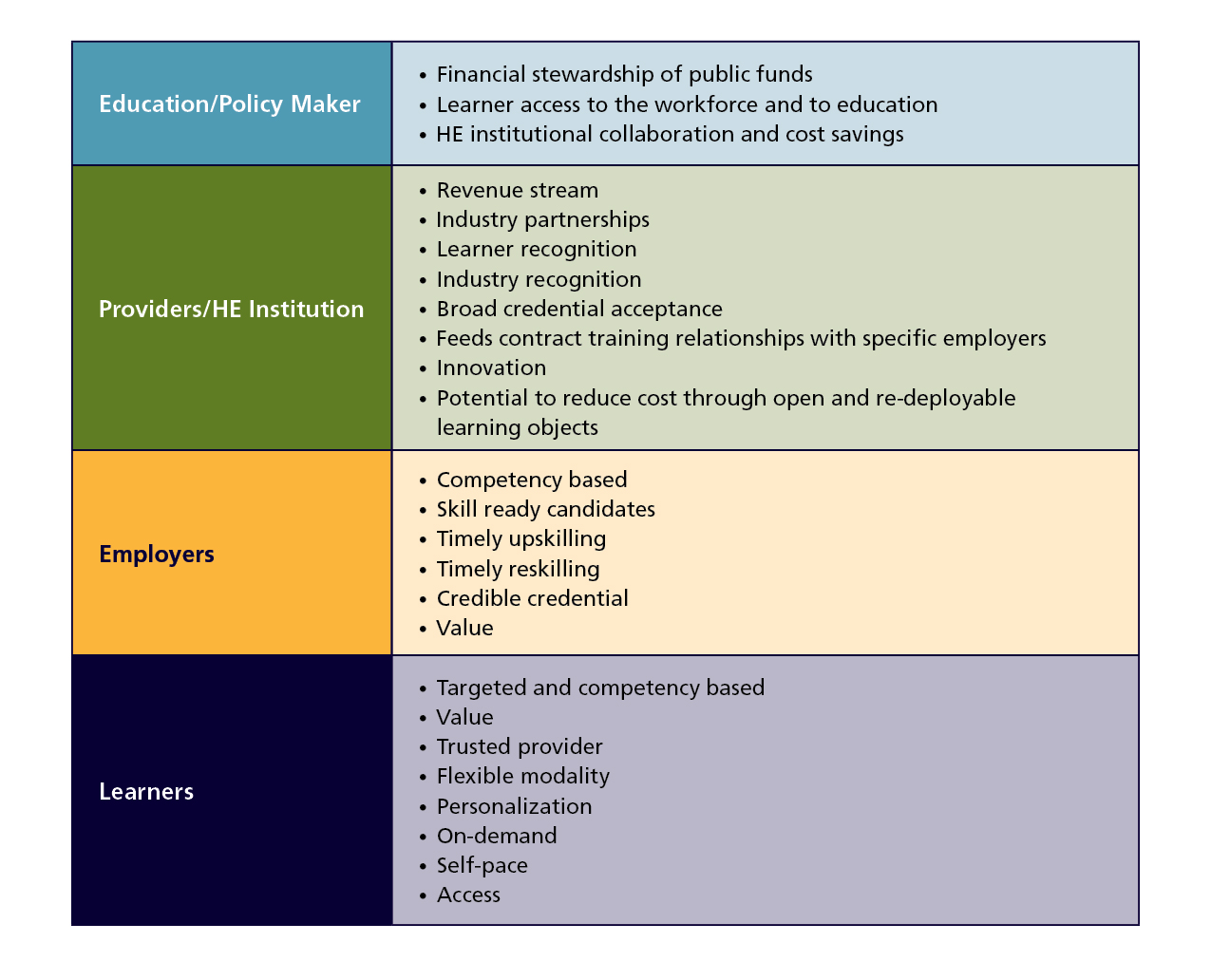
Marketing collaborators
Marketing encompasses a variety of approaches and ideas that involve collaboration to facilitate awareness of micro-credentials with stakeholders: employers, educators, and learners. As a start, it would be useful to explore how your project is approaching marketing. Are you hoping to encourage a general awareness of micro-credentials at a system level? Institutional brand awareness? Specific tactical approaches for a micro-credential or a cluster/constellation of micro-credentials? These considerations may change the location and content of your marketing efforts.
As a developer of a micro-credential, or part of a development team, it is important to ask yourself this question: “How might you raise awareness about micro-credentials and appeal to stakeholder groups to motivate collaboration for development, and/or engagement or participation in micro-credentialing?”
To answer that question, you first need to develop a message that communicates the value of the credential for your stakeholders. Developing questions using the principles of rhetorical theory to prepare your message theory can help:
- What is the subject?
- ◦ How much do stakeholders know about micro-credentials in general?
- ◦ How much do they know about a specific proposed micro-credential?
- ◦ How much do they need to know?
- What is the context?
- ◦ What is the current educational climate?
- ◦ What is precipitating the call and need for micro-credentials?
- ◦ Why do micro-credentials matter?
- ◦ What is the situation that stakeholders find themselves in (e.g., employers lacking skilled employees; students needing something extra on their resume)?
Exploring these topics leads to two important and interrelated questions: What is the purpose of the micro-credential? Who is the audience?
- Defining the purpose of your micro-credential: Your purpose can be defined in a kind of course description, highlighting how micro-credentials are different from a course that is part of a program. you can do this in just a few sentences, in the following format:
- Sentence 1: What specific topic does your micro-credential cover?
- Sentence 2: What things will people do in this micro-credential?
- Sentence 3: Who are the people you are anticipating will take this?
- Sentence 4: What professional value might those people receive from it?
- Defining your audience. There are two distinct steps in the process of defining your audience: describing the target market from viewpoint of the content expert, and doing the marketing research, performed by a professional who might ask questions like:
-
- Can you describe the kind of person who you imagine taking this micro-credential? What is their current education level? Do they work in a particular profession? What part of their career might they be in?
- If you were to guess, how many people do you think there are who would be specifically interested in this micro-credential?
- If you were to try and reach these potential students, where would you go?
Employers and lifelong learning
Employers are increasingly interested in demonstrable skills and a clear commitment to lifelong learning when hiring. A study by Northeastern University in the US shows a significant shift in focus away from formal degree and diploma credentials to clear evidence of skills and competencies (Gallagher, 2018):
- 23% of companies surveyed already prefer skills-based evidence over degrees.
- 39% indicated they were moving in this direction.
- 64% saw micro-credentials as demonstrating a commitment to lifelong learning—something they valued highly.
- 55% saw micro-credentials gradually diminishing the emphasis on degree-based hiring.
Several companies, including Google, EY, Penguin-Random House, Costco, Whole Foods, Hilton, Publix, Apple, Starbucks, Home Depot, IBM, Bank of America, and Lowe’s, no longer use degrees as a major requirement of hiring.
To support workforce training, in 2020 the federal government introduced the Canada Training Credit. Individuals may take advantage of this annual $250 tax credit by claiming accredited training (Government of Canada, 2019).
For more information on the marketing and launch of micro-credentials, refer to section 3,“Micro-Credential Lifecycle: From Sunrise to Sunset” in Part 1.

